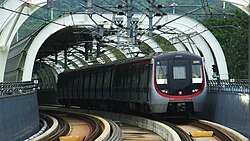CNR Changchun EMU (C/S-Train) C6554-07E / C6554-12E 港鐵市區綫中國製列車 港鐵南港島綫中國製列車 | |
|---|---|
MTR C-train on the Kwun Tong line MTR S-train on the South Island line. | |
C-Train interior S-Train interior | |
| In service |
|
| Manufacturer | CNR Changchun Railway Vehicles |
| Built at | Changchun, Jilin, China |
| Family name |
|
| Constructed | 2010–2014 |
| Entered service |
|
| Number built |
|
| Formation |
|
| Capacity |
|
| Operators | MTR |
| Depots |
|
| Lines served | |
| Specifications | |
| Car body construction | Stainless steel |
| Car length | see the corresponding table |
| Width |
|
| Height |
|
| Floor height | 1,100 mm (3 ft 7.307 in) |
| Doors | 10 per carriage (5 doors per side) |
| Maximum speed |
|
| Axle load | 17.5 t (17.2 long tons; 19.3 short tons) [2] |
| Traction system | 2-level IGBT–VVVF
|
| Traction motors | 3-phase AC induction motors
|
| Power output |
|
| Acceleration |
|
| Deceleration |
|
| Electric system(s) | 1,500 V DC overhead line |
| Current collector(s) | Pantograph |
| UIC classification |
|
| Bogies | CW6000D (powered), CW6000 (trailer) |
| Braking system(s) | Knorr-Bremse electropneumatic and regenerative
|
| Safety system(s) |
|
| Coupling system | BSI |
| Seating | Longitudinal |
| Track gauge |
|
The Changchun EMU or CNR Changchun EMU is an electric multiple unit train type of the Mass Transit Railway (MTR) system in Hong Kong. Designed and manufactured by Changchun Railway Vehicles, a member of CNR group (now merged with CSR to form CRRC), they were the first MTR heavy-rail stock to be manufactured in Mainland China, while past orders came from England, Japan, Europe or South Korea.
Contents
- History
- Train configurations
- Kwun Tong line (contract number C6554-07E - 22 sets)
- South Island line (contract number C6554-12E - 10 sets)
- In popular culture
- References
- External links
The trains come in two versions: the C-Train, a manned eight-car train which is used mainly on the Kwun Tong line; [3] and the S-Train, a driverless three-car variant which operates on the South Island line since its opening in December 2016. Similar trains had been ordered for the Tuen Ma line, also known as TML C-Train, which entered service on the Ma On Shan line on 12 March 2017; however, these trains bear a resemblance to the older SP1900 EMUs.



